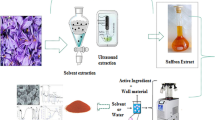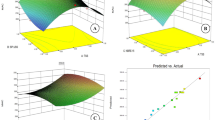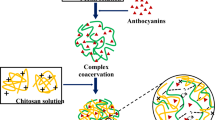Abstract
An efficient method based on encapsulation efficiency of Syzygium cumini anthocyanin extract (ANC.E) was established by using a stable concentration from (ANC.E) and sodium alginate (SA) as a first step to interact with different concentrations from maltodextrin (MD), gum Arabic (GA) and chitosan (CH) as second carriers for the second step. Freeze-drying was used to fabricate particles from different gelling optimized blends. The encapsulation efficiency, Fourier transform-infrared spectroscopy (FT-IR), thermal behavior, morphological structure, physical properties, ANC.E degradation and color properties during storage days greatly influenced. The optimum encapsulation efficiency 92.4% was achieved by SA (1.5% w/v) and CH (0.8% w/v) in ANC.E (278.21 mg/100 mL) solution named SA.CH particles. The SA.CH particles surface were like-sheet particles and were unique in FT-IR analysis that showed new peaks and shifting in wave numbers. Additionally, the SA (1.5% w/v) and GA (0.8% w/v) in ANC.E (278.21 mg/100 mL) solution named SA.GA particles besides the SA.CH particles decreased the ANC.E degradation rate to 3.57 and 3.96%, respectively, compared with other tested particles. Moreover, they showed non-significant differences in color properties during the storage days. Therefore, the obtained results provided a potential approach to utilize ANC.E as colorants or healthy ingredients in functional food.
Graphic Abstract





Similar content being viewed by others
Abbreviations
- ANC.E:
-
Syzygium cumini anthocyanin extract
- SA:
-
Sodium alginate
- MD:
-
Maltodextrin
- GA:
-
Gum Arabic
- CH:
-
Chitosan
- SA.SA:
-
Sodium alginate particles
- SA.MD:
-
Sodium alginate maltodextrin particles
- SA.GA:
-
Sodium alginate gum Arabic particles
- SA.CH:
-
Sodium alginate chitosan particles
- FD.E:
-
Freeze-dried extract
References
Jakobek L, Drenjančević M, Jukić V, Šeruga M (2012) Phenolic acids, flavonols, anthocyanins and antiradical activity of “Nero”,“Viking”,“Galicianka” and wild chokeberries. Sci Hortic 147:56–63. https://doi.org/10.1016/j.scienta.2012.09.006
Chatterjee D, Bhattacharjee P (2015) Encapsulation of colour from peels of eggplant in calcium alginate matrix. Nutrafoods 14(2):87–96. https://doi.org/10.1007/s13749-015-0001-5
Pieczykolan E, Kurek MA (2019) Use of guar gum, gum Arabic, pectin, beta-glucan and inulin for microencapsulation of anthocyanins from chokeberry. Int J Biol Macromol 129:665–671. https://doi.org/10.1016/j.ijbiomac.2019.02.073
Singh JP, Kaur A, Shevkani K, Singh N (2015) Influence of jambolan (Syzygium cumini) and xanthan gum incorporation on the physicochemical, antioxidant and sensory properties of gluten-free eggless rice muffins. Int J Food Sci Technol 50(5):1190–1197. https://doi.org/10.1111/ijfs.12764
Li L, Adams LS, Chen S, Killian C, Ahmed A, Seeram NP (2009) Eugenia jambolana Lam. berry extract inhibits growth and induces apoptosis of human breast cancer but not non-tumorigenic breast cells. J Agric Food Chem 57(3):826–831. https://doi.org/10.1021/jf803407q
Ramya S, Neethirajan K, Jayakumararaj R (2012) Profile of bioactive compounds in Syzygium cumini—a review. J Pharm Res 5(1):4548–4553
Abdin M, Hamed YS, Akhtar HMS, Chen D, Chen G, Wan P, Zeng X (2020) Antioxidant and anti-inflammatory activities of target anthocyanins di‐glucosides isolated from Syzygium cumini pulp by high speed counter‐current chromatography. J Food Biochem 44(6):1050–1062. https://doi.org/10.1111/jfbc.13209
Giampieri F, Alvarez-Suarez JM, Battino M (2014) Strawberry and human health: effects beyond antioxidant activity. J Agric Food Chem 62(18):3867–3876. https://doi.org/10.1021/jf405455n
Delgado-Vargas F, Jiménez A, Paredes-López O (2000) Natural pigments: carotenoids, anthocyanins, and betalains—characteristics, biosynthesis, processing, and stability. Crit Rev Food Sci Nutr 40(3):173–289. https://doi.org/10.1080/10408690091189257
Loypimai P, Moongngarm A, Chottanom P, Moontree T (2015) Ohmic heating-assisted extraction of anthocyanins from black rice bran to prepare a natural food colourant. Innov Food Sci Emerg Technol 27:102–110. https://doi.org/10.1016/j.ifset.2014.12.009
Giusti MM, Wrolstad RE (2003) Acylated anthocyanins from edible sources and their applications in food systems. Biochem Eng J 14(3):217–225. https://doi.org/10.1016/S1369-703X(02)00221-8
Subash S, Essa MM, Al-Adawi S, Memon MA, Manivasagam T, Akbar M (2014) Neuroprotective effects of berry fruits on neurodegenerative diseases. Neural Regen Res 9(16):1557. https://doi.org/10.4103/1673-5374.139483
Liu Y, Tikunov Y, Schouten RE, Marcelis LF, Visser RG, Bovy A (2018) Anthocyanin biosynthesis and degradation mechanisms in Solanaceous vegetables: a review. Front Chem 6:52. https://doi.org/10.3389/fchem.2018.00052
Zhang T, Lv C, Chen L, Bai G, Zhao G, Xu C (2014) Encapsulation of anthocyanin molecules within a ferritin nanocage increases their stability and cell uptake efficiency. Food Res Int 62:183–192. https://doi.org/10.1016/j.foodres.2014.02.041
Jafari SM, Assadpoor E, He Y, Bhandari B (2008) Encapsulation efficiency of food flavours and oils during spray drying. Dry Technol 26(7):816–835. https://doi.org/10.1080/07373930802135972
Robert P, Gorena T, Romero N, Sepulveda E, Chavez J, Saenz C (2010) Encapsulation of polyphenols and anthocyanins from pomegranate (Punica granatum) by spray drying. Int J Food Sci Technol 45(7):1386–1394. https://doi.org/10.1111/j.1365-2621.2010.02270.x
Passos AdS, Madrona G, Marcolino V, Baesso M, Matioli G (2015) The use of thermal analysis and photoacoustic spectroscopy in the evaluation of maltodextrin microencapsulation of anthocyanins from juçara palm fruit (Euterpe edulis Mart.) and their application in food. Food Technol Biotechnol 53(4):385–396. https://doi.org/10.17113/ftb.53.04.15.3726
Ceballos AM, Giraldo GI, Orrego CE (2012) Effect of freezing rate on quality parameters of freeze dried soursop fruit pulp. J Food Eng 111(2):360–365. https://doi.org/10.1016/j.jfoodeng.2012.02.010
Baysal K, Aroguz AZ, Adiguzel Z, Baysal BM (2013) Chitosan/alginate crosslinked hydrogels: preparation, characterization and application for cell growth purposes. Int J Biol Macromol 59:342–348. https://doi.org/10.1016/j.ijbiomac.2013.04.073
Bakowska-Barczak AM, Kolodziejczyk PP (2011) Black currant polyphenols: their storage stability and microencapsulation. Ind Crops Prod 34(2):1301–1309. https://doi.org/10.1016/j.indcrop.2010.10.002
Ahmed M, Akter MS, Lee J-C, Eun J-B (2010) Encapsulation by spray drying of bioactive components, physicochemical and morphological properties from purple sweet potato. LWT Food Sci Technol 43(9):1307–1312. https://doi.org/10.1016/j.lwt.2010.05.014
Hoemann C, Chenite A, Sun J, Hurtig M, Serreqi A, Lu Z, Rossomacha E, Buschmann M (2007) Cytocompatible gel formation of chitosan-glycerol phosphate solutions supplemented with hydroxyl ethyl cellulose is due to the presence of glyoxal. J Biomed Mater Res A 83(2):521–529. https://doi.org/10.1002/jbm.a.31365
Costa-Pinto AR, Reis RL, Neves NM (2011) Scaffolds based bone tissue engineering: the role of chitosan. Tissue Eng B 17(5):331–347. https://doi.org/10.1089/ten.teb.2010.0704
Hosseini A, Jafari SM, Mirzaei H, Asghari A, Akhavan S (2015) Application of image processing to assess emulsion stability and emulsification properties of Arabic gum. Carbohydr Polym 126:1–8. https://doi.org/10.1016/j.carbpol.2015.03.020
Jin H, Liu Y, Guo Z, Yang F, Wang J, Li X, Peng X, Liang X (2015) High-performance liquid chromatography separation of cis–trans anthocyanin isomers from wild Lycium ruthenicum Murr. employing a mixed-mode reversed-phase/strong anion-exchange stationary phase. J Agric Food Chem 63(2):500–508. https://doi.org/10.1021/jf504525w
AOAC (2005) Official methods of analysis of the Association of Official Analytical Chemists, vol II, 14th edn. Association of Official Analytical Chemists, Washington, DC
Cai Y, Corke H (2000) Production and properties of spray-dried Amaranthus betacyanin pigments. J Food Sci 65(7):1248–1252. https://doi.org/10.1111/j.1365-2621.2000.tb10273.x
Goula AM, Adamopoulos KG (2010) A new technique for spray drying orange juice concentrate. Innov Food Sci Emerg Technol 11(2):342–351. https://doi.org/10.1016/j.ifset.2009.12.001
Cano-Chauca M, Stringheta P, Ramos A, Cal-Vidal J (2005) Effect of the carriers on the microstructure of mango powder obtained by spray drying and its functional characterization. Innov Food Sci Emerg Technol 6(4):420–428. https://doi.org/10.1016/j.ifset.2005.05.003
da Silva Carvalho AG, da Costa Machado MT, Barros HDdFQ, Cazarin CBB, Junior MRM, Hubinger MD (2019) Anthocyanins from jussara (Euterpe edulis Martius) extract carried by calcium alginate beads pre-prepared using ionic gelation. Powder Technol 345:283–291. https://doi.org/10.1016/j.powtec.2019.01.016
da Rosa JR, Nunes GL, Motta MH, Fortes JP, Weis GCC, Hecktheuer LHR, Muller EI, de Menezes CR, da Rosa CS (2019) Microencapsulation of anthocyanin compounds extracted from blueberry (Vaccinium spp.) by spray drying: characterization, stability and simulated gastrointestinal conditions. Food Hydrocoll 89:742–748. https://doi.org/10.1016/j.foodhyd.2018.11.042
Veigas JM, Narayan MS, Laxman PM, Neelwarne B (2007) Chemical nature, stability and bioefficacies of anthocyanins from fruit peel of Syzygium cumini Skeels. Food Chem 105(2):619–627. https://doi.org/10.1016/j.foodchem.2007.04.022
Jampani C, Naik A, Raghavarao K (2014) Purification of anthocyanins from jamun (Syzygium cumini L.) employing adsorption. Sep Purif Technol 125:170–178. https://doi.org/10.1016/j.seppur.2014.01.047
Nayak AK, Das B, Maji R (2012) Calcium alginate/gum Arabic beads containing glibenclamide: development and in vitro characterization. Int J Biol Macromol 51(5):1070–1078. https://doi.org/10.1016/j.ijbiomac.2012.08.021
Ferreira DS, Faria AF, Grosso CR, Mercadante AZ (2009) Encapsulation of blackberry anthocyanins by thermal gelation of curdlan. J Braz Chem Soc 20(10):1908–1915. https://doi.org/10.1590/S0103-50532009001000020
Kanokpanont S, Yamdech R, Aramwit P (2018) Stability enhancement of mulberry-extracted anthocyanin using alginate/chitosan microencapsulation for food supplement application. Artif Cells Nanomed Biotechnol 46(4):773–782. https://doi.org/10.1080/21691401.2017.1339050
Pongjanyakul T, Rongthong T (2010) Enhanced entrapment efficiency and modulated drug release of alginate beads loaded with drug–clay intercalated complexes as microreservoirs. Carbohydr Polym 81(2):409–419. https://doi.org/10.1016/j.carbpol.2010.02.038
Pongjanyakul T, Puttipipatkhachorn S (2007) Xanthan–alginate composite gel beads: molecular interaction and in vitro characterization. Int J Pharm 331(1):61–71. https://doi.org/10.1016/j.ijpharm.2006.09.011
Cho AR, Chun YG, Kim BK, Park DJ (2014) Preparation of alginate–CaCl2 microspheres as resveratrol carriers. J Mater Sci 49(13):4612–4619. https://doi.org/10.1007/s10853-014-8163-x
Pasukamonset P, Kwon O, Adisakwattana S (2016) Alginate-based encapsulation of polyphenols from Clitoria ternatea petal flower extract enhances stability and biological activity under simulated gastrointestinal conditions. Food Hydrocoll 61:772–779. https://doi.org/10.1016/j.foodhyd.2016.06.039
Wang L, Khor E, Lim LY (2001) Chitosan–alginate–CaCl2 system for membrane coat application. J Pharm Sci 90(8):1134–1142. https://doi.org/10.1002/jps.1067
Li P, Dai Y-N, Zhang J-P, Wang A-Q, Wei Q (2008) Chitosan-alginate nanoparticles as a novel drug delivery system for nifedipine. Int J Biomed Sci 4(3):221
Ghasemlou M, Khodaiyan F, Oromiehie A (2011) Physical, mechanical, barrier, and thermal properties of polyol-plasticized biodegradable edible film made from kefiran. Carbohydr Polym 84(1):477–483. https://doi.org/10.1016/j.carbpol.2010.12.010
Oun AA, Rhim J-W (2017) Carrageenan-based hydrogels and films: effect of ZnO and CuO nanoparticles on the physical, mechanical, and antimicrobial properties. Food Hydrocoll 67:45–53. https://doi.org/10.1016/j.foodhyd.2016.12.040
Kuck LS, Noreña CPZ (2016) Microencapsulation of grape (Vitis labrusca var. Bordo) skin phenolic extract using gum Arabic, polydextrose, and partially hydrolyzed guar gum as encapsulating agents. Food Chem 194:569–576. https://doi.org/10.1016/j.foodchem.2015.08.066
Synowiec A, Gniewosz M, Kraśniewska K, Przybył JL, Bączek K, Węglarz Z (2014) Antimicrobial and antioxidant properties of pullulan film containing sweet basil extract and an evaluation of coating effectiveness in the prolongation of the shelf life of apples stored in refrigeration conditions. Innov Food Sci Emerg Technol 23:171–181. https://doi.org/10.1016/j.ifset.2014.03.006
Nayak AK, Pal D, Santra K (2016) Swelling and drug release behavior of metformin HCl-loaded tamarind seed polysaccharide-alginate beads. Int J Biol Macromol 82:1023–1027. https://doi.org/10.1016/j.ijbiomac.2015.10.027
Tsai F-H, Kitamura Y, Kokawa M (2017) Effect of gum Arabic-modified alginate on physicochemical properties, release kinetics, and storage stability of liquid-core hydrogel beads. Carbohydr Polym 174:1069–1077. https://doi.org/10.1016/j.carbpol.2017.07.031
Roos Y (1995) Characterization of food polymers using state diagrams. J Food Eng 24(3):339–360. https://doi.org/10.1016/0260-8774(95)90050-L
Nayak CA, Rastogi NK (2010) Effect of selected additives on microencapsulation of anthocyanin by spray drying. Dry Technol 28(12):1396–1404. https://doi.org/10.1080/07373937.2010.482705
Mahdavi SA, Jafari SM, Assadpoor E, Dehnad D (2016) Microencapsulation optimization of natural anthocyanins with maltodextrin, gum Arabic and gelatin. Int J Biol Macromol 85:379–385. https://doi.org/10.1016/j.ijbiomac.2016.01.011
Tonon RV, Brabet C, Hubinger MD (2010) Anthocyanin stability and antioxidant activity of spray-dried açai (Euterpe oleracea Mart.) juice produced with different carrier agents. Food Res Int 43(3):907–914. https://doi.org/10.1016/j.foodres.2009.12.013
Mohd Nawi N, Muhamad II, Mohd Marsin A (2015) The physicochemical properties of microwave-assisted encapsulated anthocyanins from Ipomoea batatas as affected by different wall materials. Food Sci Nutr 3(2):91–99. https://doi.org/10.1002/fsn3.132
Quek SY, Chok NK, Swedlund P (2007) The physicochemical properties of spray-dried watermelon powders. Chem Eng Process 46(5):386–392. https://doi.org/10.1016/j.cep.2006.06.020
Syamaladevi RM, Insan SK, Dhawan S, Andrews P, Sablani SS (2012) Physicochemical properties of encapsulated red raspberry (Rubus idaeus) powder: influence of high-pressure homogenization. Dry Technol 30(5):484–493. https://doi.org/10.1080/07373937.2011.647369
Vieira MGA, da Silva MA, dos Santos LO, Beppu MM (2011) Natural-based plasticizers and biopolymer films: a review. Eur Polym J 47(3):254–263. https://doi.org/10.1016/j.eurpolymj.2010.12.011
Rein MJ, Renouf M, Cruz-Hernandez C, Actis‐Goretta L, Thakkar SK, da Silva Pinto M (2013) Bioavailability of bioactive food compounds: a challenging journey to bioefficacy. Br J Clin Pharmacol 75(3):588–602. https://doi.org/10.1111/j.1365-2125.2012.04425.x
Patras A, Brunton NP, O’Donnell C, Tiwari B (2010) Effect of thermal processing on anthocyanin stability in foods; mechanisms and kinetics of degradation. Trends Food Sci Technol 21(1):3–11. https://doi.org/10.1016/j.tifs.2009.07.004
Idham Z, Muhamad II, Sarmidi MR (2012) Degradation kinetics and color stability of spray-dried encapsulated anthocyanins from Hibiscus sabdariffa l. J Food Process Eng 35(4):522–542. https://doi.org/10.1111/j.1745-4530.2010.00605.x
Vuillemin ME, Michaux F, Muniglia L, Linder M, Jasniewski J (2019) Gum Arabic and chitosan self-assembly: thermodynamic and mechanism aspects. Food Hydrocoll. https://doi.org/10.1016/j.foodhyd.2019.05.048
Aberkane L, Jasniewski J, Gaiani C, Scher J, Sanchez C (2010) Thermodynamic characterization of acacia gum-β-lactoglobulin complex coacervation. Langmuir 26(15):12523–12533. https://doi.org/10.1021/la100705d
Shaddel R, Hesari J, Azadmard-Damirchi S, Hamishehkar H, Fathi-Achachlouei B, Huang Q (2018) Use of gelatin and gum Arabic for encapsulation of black raspberry anthocyanins by complex coacervation. Int J Biol Macromol 107:1800–1810. https://doi.org/10.1016/j.ijbiomac.2017.10.044
Acknowledgements
The study was supported by a project funded by the Priority Academic Program Development of Jiangsu Higher Education Institutions (PAPD).
Author information
Authors and Affiliations
Corresponding author
Ethics declarations
Conflict of interest
The authors have declared that there is no conflict of interest.
Additional information
Publisher’s note
Springer Nature remains neutral with regard to jurisdictional claims in published maps and institutional affiliations.
Rights and permissions
About this article
Cite this article
Abdin, M., Salama, M.A., Gawad, R.M.A. et al. Two‐Steps of Gelation System Enhanced the Stability of Syzygium cumini Anthocyanins by Encapsulation with Sodium Alginate, Maltodextrin, Chitosan and Gum Arabic. J Polym Environ 29, 3679–3692 (2021). https://doi.org/10.1007/s10924-021-02140-3
Accepted:
Published:
Issue Date:
DOI: https://doi.org/10.1007/s10924-021-02140-3




